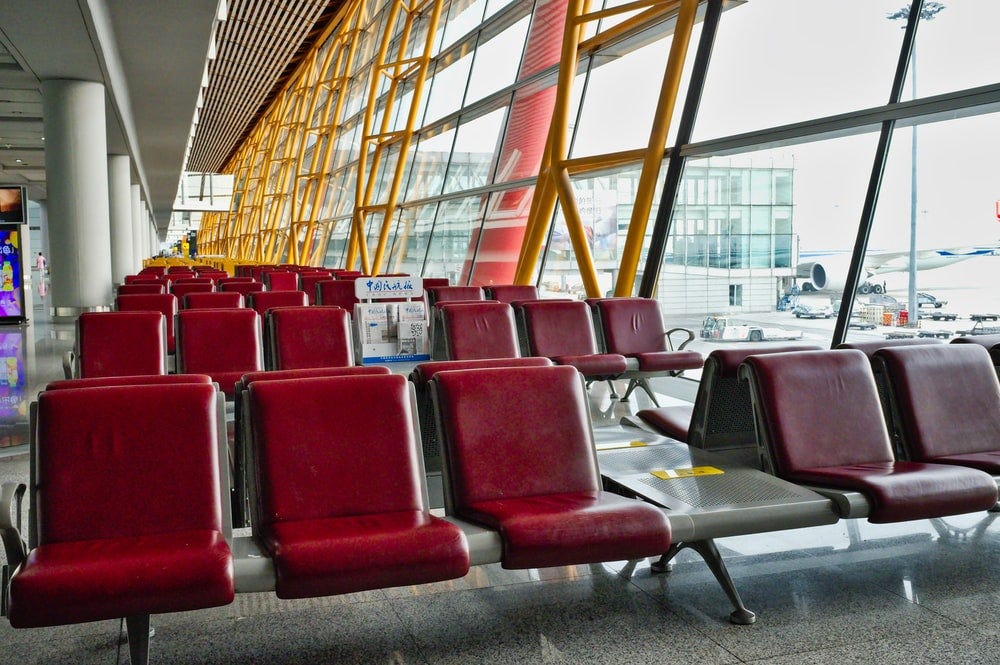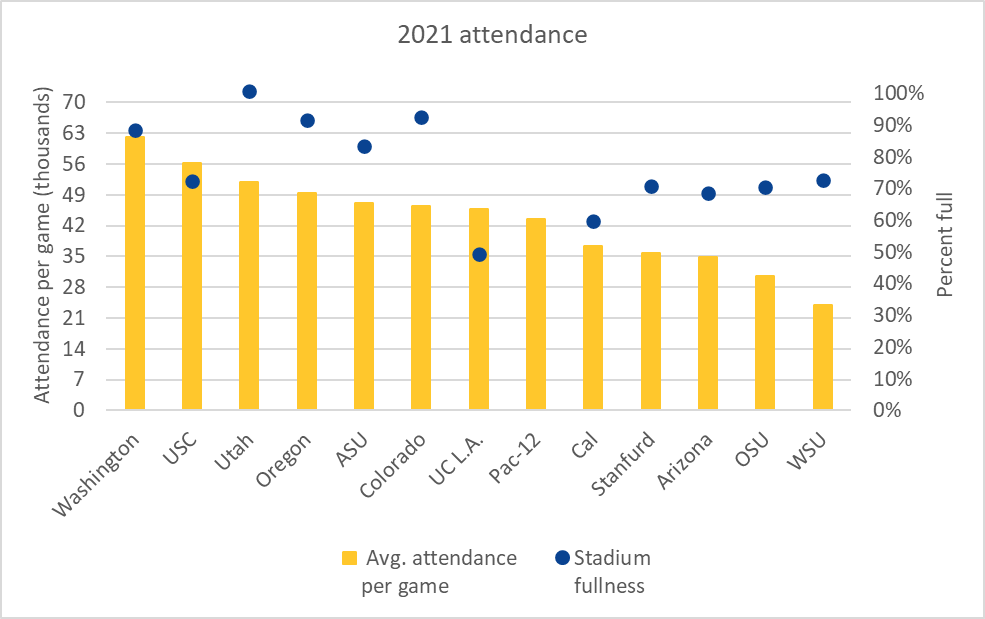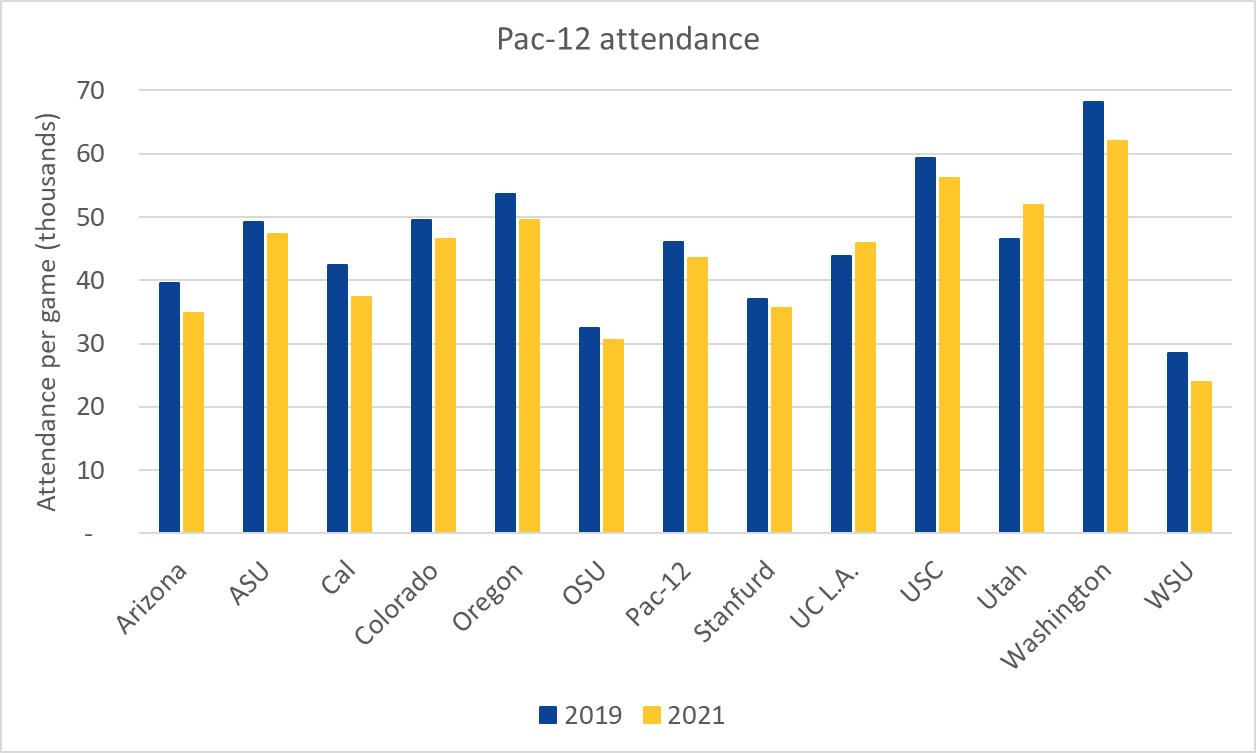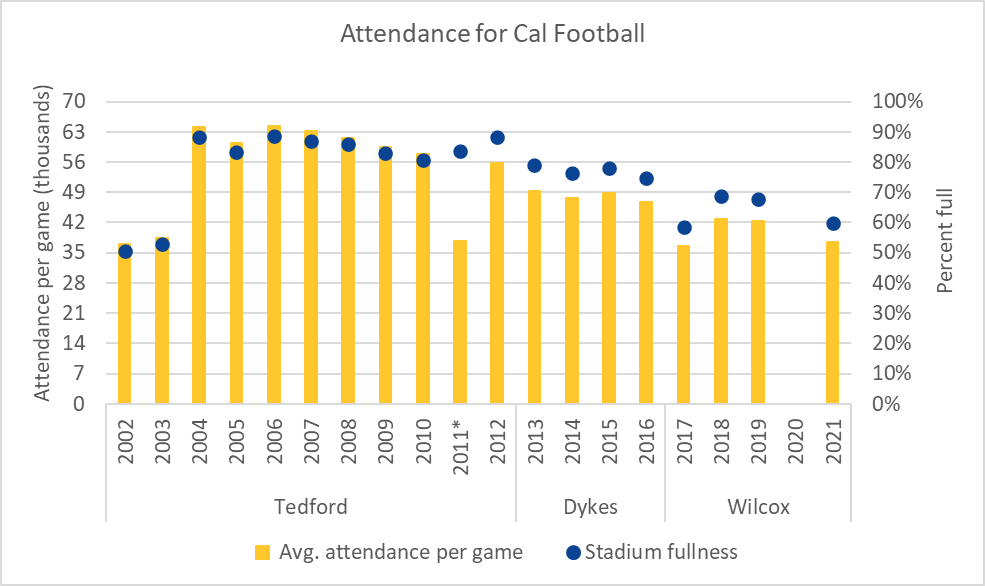Cal Football attendance in 2021 and why I should never be optimistic ever
The glass was once half-full because it had been spilling out all over me.
Everyone knows the best way to say goodbye is a quick calc-you-later, so I have to write one more numbers post before my time on this site ends this season and what better topic than Cal Football attendance—an evergreen focus of fan anguish and hand-wringing?
Unfortunately, the NCAA won’t be releasing their attendance figures for a few more months, so the only way for me to get this post out given the timing is to use numbers from the wholly convenient and wildly unreliable Wikipedia.
The following graph (Fig. 1) shows the per-game average attendance for each Pac-12 school and the conference average. With attendance booming at Washington, I really can’t fathom why they ever got rid of Jimmy Lake—give him a 15-year extension! Unfortunately, the Bears come in below the Pac-12 average; though the UC Berkeley students among our fanbase are certainly well-accustomed to coming in below the average on an exam, this is still troubling for the football team.
Perhaps of greatest concern is that the gap between California and Stanfurd attendance is shrinking; Figure 1 shows how close the Bay Area rivals were in 2021 compared to this same analysis in 2019. That being said, I’m put somewhat at ease when you look at our schedules against in-state rivals—which were the biggest crowds in Stanfurd Stadium by a large margin at 47k and 49k, whereas no other home game was able to crack 32k. Early on in the season, Stanfurd still managed to have an winning record (2–1) while they hosted a UCLA team that was nationally ranked and nationally relevant with a win over LSU; they also got the Big Game, which always draws—plus, Cal was still hanging on by a thread to bowl contention at the time. On the other hand, there was less variation in Cal’s attendance based on opponent (35k to 42k if you throw out the Sac State game) and our one visit from a Californian rival was a late-night game against USC that was rescheduled on short notice and when the two teams were guaranteed to be bowl-ineligible.
Moving on (Fig. 2), we have a comparison between this year’s (unofficial) data and the NCAA’s official attendance data for 2019 from our last breakdown—since that was the last year that fans were allowed to attend Pac-12 games. Almost all of the schools saw decreases compared to their 2019 attendance; on average, the Pac-12 attendance in 2021 dropped by 5.7% compared to 2019. The team with the biggest percent decrease compared to 2019 was Washington State, which lost 16.1% of their 2019 crowd. The next biggest percent decreases were for the Golden Bears and the Wildcats at 11.9 and 11.7%. Only UCLA and Utah saw increases, with the former likely being attributed to Chip Kelly finally somewhat figuring things out for the first time in Westwood.
So, how does the 2021 data look relative to Cal’s historical data? Figure 3 shows the attendance at Memorial Stadium for NCAA-official numbers from 2002–2019, a COVID-cancelled 2020, and Wikipedia-stated 2021. As previously mentioned, the crowds at Strawberry Canyon took a bit of a hit compared to 2019—which makes me feel pretty damn foolish for once being optimistic about the future of Cal Football and its attendance in 2019. Life—always there to sweep the rug out from under you.
It’s tough to pinpoint why exactly Cal’s attendance is dropping—and it’s the job of people far smarter than me who are getting paid by the athletic department to figure out why. Across the conference, there’s an almost-universal drop with ten of the twelve teams seeing decreases of varying magnitudes compared to their 2019 numbers (Fig. 2). This suggests there may be a common cause for the drops and the big thing that should be on the front of all our minds (and faces) is the coronavirus. It’s possible that COVID awakened an epiphany in West Coast fanbases that there’s more to life than the anguish that is college football (which should especially resonate with you as a Cal fan). Alternatively, it’s possible that this subset of fans feels uncomfortable being so close thousands of strangers in a venue with no mask enforcement—even if it is outdoors.
Refocusing on Memorial Stadium, the one way that I can polish this data is with continued hope and optimism—which is crazy because I just bemoaned the last time I felt optimism for our attendance because life has taught me that hope is hopeless. But besides just winning, I see one possible way for our numbers to start improving. With Justin Wilcox reportedly turning down an offer from the moneybags that is Scrooge McDuck, Golden Bears have taken to the internet to rejoice and express a renewed sense of vigor that someone chose us. If this enthusiasm can translate to ticket sales, if the team can keep winning, and if we get some better luck in one-score games, then hopefully all the components are there for things to turn up






I don’t think Covid had much of an affect on attendance. In fact, people were excited to get back to normalcy after a year without being able to attend a game, especially early in the season. Pac12, like all conferences, sold their soul to the networks, and the affect on attendance is not at all surprising:
• Not setting game times until 12 or even 6 days before kickoff. People need to be able to plan. If the gametime isn’t set, people will prioritize other events, family activities, etc. It’s like asking a girl out but not telling her what time you’ll pick her up until the day of your date. If you’re not going to commit to her, why should she want to go out with you?
• Too many night kickoffs. Before moving back to the Bay Area 15 years ago, I used to drive down from the Folsom area with my young kids, rarely missing a game. There’s no way I could do that with so many 7:30 and 8pm kickoffs, as I wouldn’t get home until 1:00am at the earliest. It’s also tough on octogenarians who don’t want to be driving that late.
• Waiting too late to set the schedule. Kudos to the Pac12 for announcing the 2022 schedule last month. In recent years we’ve had to wait until February or March. As a result many people are unable to schedule their vacations around Cal football games. (September and November are great months to visit Europe, but generally you have to book your trip many months in advance.)
• We’ve already lost a generation of potential fans owing to the above reasons. The biggest hit on attendance as a result of whoring to the networks is the inability of young families to attend games. My kids, now all in their 20s, love to go to games because it’s in their DNA. Kids who have grown up in the “networks first” era, have never had the game experience, have no desire to go, and won’t be bringing their kids to games.
Priority 1 for George Kliavkoff in the next TV deal should be to allow the conference to have greater control of scheduling, especially kickoff times. If the basketball schedule, with 3X as many games, can be set, including tipoff times for all but a couple of games, why can’t they do it for football? Given that it’s a zero sum game, I doubt all the last-minute jockeying to select games makes any difference to overall viewership for each network. I also think it would be easier/more efficient for the networks to move their resources as necessary if kickoff times were set earlier.
There is a cumulative effect of fan-unfriendly events in recent years (clear bag non-sense, body scans at some Pac-12 venues, price gouging on tickets and especially parking, and hotel prices, ever more Pac-12 looong looong after dark, and on it goes), which was significantly exacerbated this year by a widespread move to e-ticketing. I wound up in position of trying to get a surplus ticket to an attractive OSU home game (Utah), a Cal game (OSU at Cal was not "unattractive" at the time), and the LA Bowl, and I couldn't give them away (never mind resell them). Multiple people who historically would have been reasonable possibilities stated that its too much hassle, and they just weren't going to deal with it.
I do know it was a source of stress (ever try to get adequate connectivity anywhere near most stadiums on game day), in part due to terribly written apps, every week, and sometimes worse.
Some may scoff at this (including, as we have found out, athletic ticket office personnel who dismiss complaints and requests for relief), but for a significant number of the customer base that is none too large and shrinking, its real.
This was the latest in a recent run of things (some of which noted above) where the attitude has become clear that college football fans will put up with anything and everything, and some more susshine pumping is all that's needed to get tickets sold. Evidence is clear that is not the case.